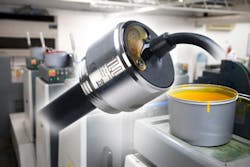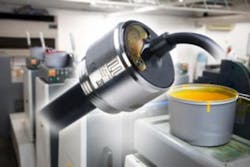Liquid level sensor meets repeatability requirements in sticky monitoring applications
Los Angeles, CA. Using highly viscous materials in manufacturing processes can become a sticky situation in more ways than one. Clogged float mechanisms, blocked fill ports, masked windows, and solid material buildup on moving floats often result in sticking floats and frozen outputs along with inaccurate readings and costly maintenance and downtime.
Gill’s new high viscosity liquid level sensor Model 7014 met these requirements by means of its proprietary conductive technology specifically designed for monitoring highly viscous (water based) liquids. The 7014 sensor features an electrically sensitive probe surface and no moving parts or floats. With this design, there is nothing to wear, freeze, or clog, allowing for a reliable signal reading while at the same time reducing maintenance costs.
The probe also features a wetted area manufactured with FEP (fluorinated ethylene propylene) that has excellent nonstick properties. The smooth sensing surface can differentiate between being immersed in thick liquids versus air (the airspace at the top of the tank or container). The variance between these two readings is used to calculate true liquid level.
“Gill’s 7014 sensor technology allows engineers to ‘install it and forget it,’” said Paul Cain, manager of business development for Gill Sensors North America. “The unique profiling software calibrates each tank or container to obtain gauge readings where a ½-tank indication truly means 50% of actual level.”
The 7014 sensor can be used for level monitoring in water-based paint solids, lacquers, and pulp products along with other aggressive water-based cleaning chemical combinations commonly used in industrial processing. Even in extremely syrupy and sticky viscous materials, a simple service of wiping the probe clean using alcohol will reset the device for re-use.
The 7014’s sensor can be mounted in a ‘”bottoms up’” or inverted orientation with no impact on accuracy. The sensor is available with all of the common electrical outputs including resistive 10 to 180 Ω or 240 to 33 Ω, analog voltage output with both 0.25- to 4.75-VDC and 0.25- to 10.0-V versions, and current output with 4 to 20 mA. Easy-to-use GUI software includes a programmable switch function (output) that triggers an alarm or warning when the container or tank level has reached the user’s preselected point.
About the Author

Rick Nelson
Contributing Editor
Rick is currently Contributing Technical Editor. He was Executive Editor for EE in 2011-2018. Previously he served on several publications, including EDN and Vision Systems Design, and has received awards for signed editorials from the American Society of Business Publication Editors. He began as a design engineer at General Electric and Litton Industries and earned a BSEE degree from Penn State.

